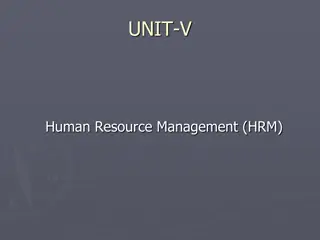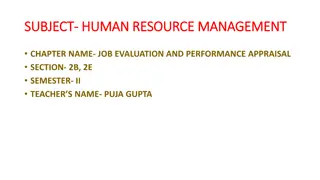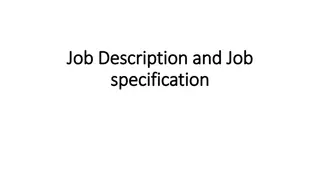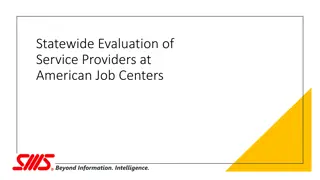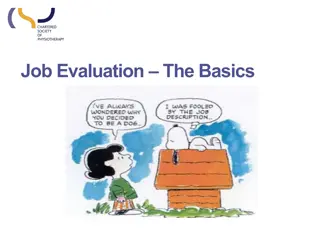Understanding Job Evaluation in Human Resource Management
Job evaluation is a systematic process that helps determine the value and worth of jobs performed within an organization, essential for establishing fair wage and salary structures. This evaluation involves assessing job demands, relative worth, skills required, and other human qualities. The primary objectives include identifying competencies, establishing equitable salary structures, and ensuring consistent wage systems. Various methods like job ranking and classification are used for job evaluation to create a fair and logical remuneration system.
Download Presentation

Please find below an Image/Link to download the presentation.
The content on the website is provided AS IS for your information and personal use only. It may not be sold, licensed, or shared on other websites without obtaining consent from the author. Download presentation by click this link. If you encounter any issues during the download, it is possible that the publisher has removed the file from their server.
E N D
Presentation Transcript
HUMAN RESOURCE MANAGEMENT UNIT 5: Job Evaluation By Prof. CHAITALI GHOSH THK JAIN COLLEGE Class- B.Com (Hons) Semester 2, Sec-2E
JOB EVALUATION Definition Job evaluation is a systematic process of evaluation and determining the value or worth of jobs performed. It helps to identify the worth or contribution of an employee s efforts within the organisation. Job evaluation is done for the purpose of establishing wage and salary credentials. The scope extends to develop an equitable wage and salary structure. According to International Labour Organisation (ILO), Job evaluation may be defined as an attempt to determine and compare the demands which the normal performance of particular jobs makes on normal workers without taking into account the individual abilities or performance of the works concerned.
Features of Job Evaluation Determining and comparing the demand of jobs Not taking into account the individual abilities or performance Determining a job s relative worth Formal and systematic comparison of jobs Analysing and assessing the content of jobs Creating a fair and logical remuneration system Knowing the skills and other human qualities required to perform the job Obtaining data that is useful in the design or redesign of the jobs
Objectives of Job Evaluation Identifying range of competencies required to perform job related duties Establishing a basis of an equitable salary structure within that organisation Finding the basis of a fair and logical remuneration system Installing system for consistent wage and salary structure Ensuring five basics- quality, speed, dependability, flexibility, and cost. Factors:- Specific training need or qualification requirements to perform the assigned tasks better Decision-making authority to develop leadership skills Problem-solving skills and independent judgement for promptness
Job Evaluation Methods 1. Job Ranking Method: It is the simplest method. Jobs are often arranged according to the relative difficulty in performing them. The job evaluation is using judgement. The evaluator just rank orders the jobs on the basis of his/her perception. This method can be easily adopted in small organizations. 2. Job Classification Method: The general purpose of a job classification method is to create and maintain pay grades for comparable work across the organisation. This method uses job classes for more customized evaluation. This method also uses scales to measure performance rather than simply comparing and ranking employee performances.
Contd.. 3. Factor Comparison Method: This method is more scientific and complex than the qualitative methods of ranking and classification. This methods assumes that there are 5 universal factors consisting of mental requirement, skills, physical requirement, responsibility, and working condition. 4. A rather using this method first identifies specific job factors such as knowledge and skills required to perform the job. Thereafter, he/she assigns numerical values to each factor. The point method measures performance through scales and job factors rather than focusing on the entire job functions and ranking employees against each other. Point Method:





